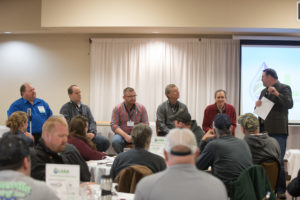Lafayette Ag Stewardship Alliance looks to the future
DARLINGTON, Wis. — More than 100 farmers, community members and agribusiness professionals came together recently to explore conservation practices and how farmers can make them economically viable.
The topics formed the core of the first annual meeting of the Lafayette Ag Stewardship Alliance (LASA) on March 1. LASA is a nonprofit farmer-led group focused on protecting and improving the quality of water and other natural resources in Lafayette County in southwestern Wisconsin.
During a panel discussion titled “Farmer-led conservation: what is working around Wisconsin, where is LASA headed?” a variety of participants shared their experiences and perspectives on current conservation in the region.

“Those of us at The Nature Conservancy realize we need to work with the folks closest to the land in order to increase conservation,” said Steve Richter, state program director. “We want to do projects that will help farms and local families and customize them to their area.”
The panelists said that to foster more conservation, groups like LASA must continue to encourage open communication between farmers, welcome people with diverse perspectives into the organizations and lead by example when asking farmers to try something new on their farms.
“Farmers are good at farming but not always at advocating. There’s a variety of conservation practices, but we have to figure out what we can do to get farmers to try some,” said Terry Loeffelholz, manager of the Lafayette County Land Conservation/Planning and Zoning Department.
Dustin Ransom of T-K Ag Works showed technology he and his parents, co-owners of T-K Ag Works, created to help with low-disturbance manure injection. The injector they created has spoons that lift the soil to create an area in which manure can settle. This technology increased pumping capacity, lowered fuel consumption and reduced soil disturbance.
The economics of manure was an important topic in a presentation by Dr. Daniel Andersen, assistant professor of agricultural and biosystems engineering at Iowa State University. Manure must be applied to the right field at the right time to be of any value to future crops, he said.
“We can make money with manure these days,” Andersen said. “But not all injection is the same.”
Heidi Johnson, crop and soils educator with Dane County University of Wisconsin-Extension, talked about the value of growing cover crops as a conservation practice. She explained how a large emphasis is put on soil health and how over time, scientists have learned that the living organisms in the soil are very beneficial and should not be killed off. Soil organisms influence soil chemistry and structure as well as pest cycles.
“Cover crops are not a fad; they’re here to stay,” Johnson said. “We used to think of the soil as dirt, as something we plant seeds in and then take a harvest out, but it’s soil, not dirt. And the health of it is crucial to your farm.”
The positive points of cover crop economics, Johnson said, include erosion reduction, forage alternative, nutrient availability to cash crops like corn and beans, more weed control, requirements met of nutrient management plans, increased organic matter, improved soil structure and health, better water infiltration, reduced soil compaction and great soil resiliency.
Negative points of cover crop economics, she said, include seed costs, custom planting requirements, specialized equipment needs, management time, potential yield drag and termination of the cover crop costs and time.
About Lafayette Ag Stewardship Alliance: Established in 2017, Lafayette Ag Stewardship Alliance is a farmer-led 501c(3) non-profit organization with a vision of a community where farmers and friends of agriculture work together to protect and improve our water quality and environment. The group is composed of member-farms with 23,350 head of livestock and 55,760 acres of land. Members represent about 20 percent of the available farm land in Lafayette County. To learn more, go to lafayetteagstewardship.org.
###
Editor’s Note: [Photos] Lafayette Ag Stewardship Alliance held its first annual meeting on March 1. Click on the links for full resolutions images. Right click on embedded logos below.
.eps logos and alternative photo delivery available by request
Panel discussion: L to R: Chuck Ripp, Terry Loeffelholz, Jim DiGangi, Pat Murphy, Steve Richter. Moderator Dennis Frame of Timber Ridge Consulting kept the conversation lively and informative as panelists Steve Richter of The Nature Conservancy, Chuck Ripp of Ripp’s Dairy Valley, Pat Murphy of Yahara Pride Farms, Jim DiGangi of Darlington Ridge Farms and Terry Loeffelholz of Lafayette County Land Conservation/Planning and Zoning shared their experiences and perspectives on current conservation in the southwestern region of the state.
Low disturbance manure injection: Dustin Ransom of T-K Ag Works has developed manure injection technology that has increased pumping capacity, lowered fuel consumption and reduced soil disturbance.
Manure economics: Dr. Daniel Andersen, assistant professor of agricultural and biosystems engineering at Iowa State University emphasized the importance of timing to maximize the value of manure.
Cover crops: Heidi Johnson, crop and soils educator with Dane County University of Wisconsin-Extension emphasized soil health and how over time, scientists have learned that the living organisms in the soil are very beneficial.
Additional photos from our Facebook page below:
